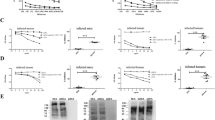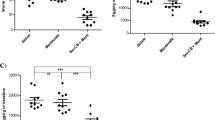Abstract
The clearance of schistosome-specific model immune complexes (IC) consisting of circulating anodic antigen (CAA), a gut-associated excretory-secretory antigen, and radiolabeled monoclonal antibody (IgG1) was investigated in mice with a light and heavy Schistosoma mansoni infection and in noninfected control animals. The size analysis of the in vitro prepared and injected IC, as determined by density gradient centrifugation, revealed a wide peak at 11S. In infected animals the injected IC were cleared at a significantly lower rate than in control mice. This was attributed to a decreased uptake of IC by the liver in infected mice. In heavily infected mice, 30 min after injection of 11S IC, 8S, 11S, and >11S IC were present in the serum, whereas only small 8S IC were detected in the serum of lightly infected animals and noninfected controls. Immune complexes were also present in the serum of heavily infected mice 30 min after injection of antibody and were detectable as 11S and >11S IC. The importance of this study is twofold. First, these results show that schistosome-specific monoclonal antibodies can be used in the production of model immune complexes applicable in clearance studies. Second, our findings might be of importance when the possible pathogenicity of circulating IC in schistosomiasis is considered.
Similar content being viewed by others
Abbreviations
- IC:
-
Immune complexes
- CAA:
-
Circulating anodic antigen
- SDG:
-
Sucrose density gradient
- S:
-
Svedberg unit
References
Berggren WL, Weller TH (1967) Immunoelectrophoretic demonstration of specific circulating antigen in animals infected with Schistosoma mansoni. Am J Trop Med Hyg 16:606–612
Carlier Y, Bout D, Bina JC, Camus D, Figueiredo JFM, Capron A (1975) Immunological studies in human schistosomiasis. I. Parasitic antigen in urine. Am J Trop Med Hyg 24:949–954
Deelder AM, Klappe HT, Van den Aardweg GJ, Van Meerbeke EH (1976) Schistosoma mansoni: demonstration of two circulating antigens in infected hamsters. Exp Parasitol 40:189–197
Deelder AM, Van Dalen DP, Van Egmond JG (1978) Schistosoma mansoni: microfluorometric determination of circulating anodic antigen and antigen-antibody complexes in infected hamster serum. Exp Parasitol 44:216–224
Deelder AM, Kornelis D, Van Marck EAE, Eveleigh PC, Van Egmond JG (1980) Schistosoma mansoni: Characterization of two circulating polysaccharide antigens and the immunological response to these antigens in mouse, hamster and human infections. Exp Parasitol 50:16–32
De Water R, Fransen JAM, Deelder AM (1986) Ultrastructural localization of the circulating anodic antigen in the digestive tract of Schistosoma mansoni using monoclonal antibodies in an immunogold labeling procedure. Am J Trop Med Hyg 35:549–558
Draper NR, Smith H (eds) (1966) Applied regression analysis. John Wiley and Sons, Inc., New York
El-Dosoky I, Van Marck EAE, Deelder AM (1984) Presence of Schistosoma mansoni antigens in liver, spleen and kidney of infected mice: a sequential study. Z Parasitenkd 70:491–497
Finbloom DS, Plotz PH (1979) Studies of reticuloendothelial function in the mouse with model immune complexes. I. Serum clearance and tissue uptake in normal C3H mice. J Immunol 123:1594–1599
Gold R, Rosen FS, Weller TH (1969) A specific circulating antigen in hamsters infected with Schistosoma mansoni. Detection of antigen in serum and urine, and correlation between antigenic concentration and worm burden. Am J Trop Med Hyg 18:545–551
Haakenstad AO, Mannik M (1974) Saturation of the reticuloendothelial system with soluble immune complexes. J Immunol 112:1939–1948
Hudson L, Hay FC (eds) (1980) Practical immunology, 2nd edn. Blackwell Scientific Publications, Oxford, pp 93–110
Hunter WM, Greenwood FC (1962) Preparation of iodine-131 labelled human growth hormone of high specific activity. Nature 94:495
Jimenez RAH, Haakenstad AO, Mannik M (1983) Hepatic uptake of small-laticed immune complexes does not alter mononuclear phagoycte system function. Immunology 48:205–210
Kestens L, Gigase PLJ (1984) Clearance kinetics of heterologous antigen and antigen-antibody complexes in Schistosoma mansoni infected mice. Ann Soc Belge Med Trop 64:21–36
Kestens L, Van Marck EAE, Gigase PLJ (1983) Clearance of in vitro prepared heterologous antigen-antibody complexes in mice infected with Schistosoma mansoni. Contr Microbiol Immunol 7:63–72
Kurlander RJ, Ellison D, Hall J (1984) The blockade of Fc receptor-mediated clearance of immune complexes in vivo by a monoclonal antibody (2.4G2) directed against FC receptors on murine leucocytes. J Immunol 133:855–862
Lichtenberg F von, Bawden MP, Shealey SH (1974) Origin of circulating antigen from the schistosome gut. An immunofluorescent study. Am J Trop Med Hyg 23:1088–1091
Mannik M, David KA (1981) Covalently cross-linked immune complexes prepared with multivalent antigens. J Immunol 127:1999–2006
Martin RG, Ames BN (1961) A method for determining the sedimentation behavior of enzymes: application to protein mixtures. J Biol Chem 236:1372–1379
Nash TE (1974) Localization of the circulating antigen within the gut of Schistosoma mansoni. Am J Trop Med Hyg 23:1085–1087
Nash TE (1978) Antibody response to a polysaccharide antigen present in the schistosome gut: I. Sensitivity and specficity. Am J Trop Med Hyg 27:938–943
Nash TE (1982) Factors that modulate clearance and ultimate fate of a specific schistosome antigen (GASP) in schistosome infections. J Immunol 128:1608–1613
Nash TE (1984) Immune complex size determines the clearance rate of a circulating antigen in schistosome-infected mice. Am J Trop Med Hyg 33:621–626
Nash TE, Deelder AM (1985) Comparison of four schistosome excretory-secretory antigens: phenol sulfuric test active peak, cathodic circulating antigen, gut-associated proteoglycan, and circulating anodic antigen. Am J Trop Med Hyg 34:236–241
Nash TE, Prescott B, Neva FA (1974) The characteristics of the circulating antigen in schistosomiasis. J Immunol 112:1500–1507
Nash TE, Nasir-Ud-Din, Jeanloz RW (1977) Further purification and characterization of a circulating antigen in schistosomiasis. J Immunol 119:1627–1633
Nash TE, Lunde MN, Cheever AW (1981) Analysis and antigenie activity of a carbohydrate fraction derived from adult Schistosoma mansoni. J Immunol 126:805–810
Nishi T, Bhan AK, Collins AB, McCluskey RT (1981) Effect of circulating immune complexes on Fc and C3 receptors of Kupffer cells in vivo. Lab Invest 44:442–448
Qian ZL, Deelder AM (1983) Schistosoma japonicum: Immunological characterization and detection of circulating polysaccharide antigens from adult worms. Exp Parasitol 55:168–178
Radke MG, Berrios-Duran LA, Moran K (1961) A perfusion procedure (perf-o-suction) for recovery of schistosome worms. J Parasitol 47:366–368
Santoro F, Vandemeulebroucke B, Capron A (1979) Schistosoma mansoni: circulating antigens and immune complexes in infected mice. Exp Parasitol 47:392–402
Smithers SR, Terry RJ (1965) The infection of laboratory host with cercariae of S. mansoni and the recovery of adult worms. Parasitology 55:711–717
Van Marck EAE (1983) The glomerulopathy associated with Schistosoma mansoni infection. An experimental study in the mouse. Acta Leiden 50:1–89
Van Marck EAE, Deelder AM, Gigase PLJ (1981) Schistosoma mansoni: anodic polysaccharide antigen in glomerular immune deposits of mice with unisexual infection. Exp Parasitol 52:62–68
Author information
Authors and Affiliations
Rights and permissions
About this article
Cite this article
Kestens, L., Mangelschots, K., Van Marck, E.A.E. et al. Schistosoma mansoni: impaired clearance of model immune complexes consisting of circulating anodic antigen and monoclonal IgG1 in infected mice. Parasitol Res 74, 356–362 (1988). https://doi.org/10.1007/BF00539458
Accepted:
Issue Date:
DOI: https://doi.org/10.1007/BF00539458




